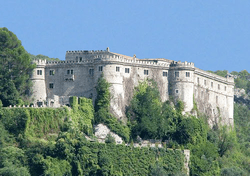Balsorano
| Balsorano | ||
|---|---|---|
| Comune | ||
| Comune di Balsorano | ||
 | ||
| ||
 Balsorano Location of Balsorano in Italy | ||
| Coordinates: 41°48′39″N 13°33′39″E / 41.81083°N 13.56083°E | ||
| Country | Italy | |
| Region | Abruzzo | |
| Province / Metropolitan city | L'Aquila (AQ) | |
| Frazioni | Balsorano vecchio, Case Marconi, Collecastagno, Collepiano, Fosse, La Selva, Grottella, Pagliare, Pelagalli, Ridotti, Tre Ponti | |
| Government | ||
| • Mayor | Carica Vacante | |
| Area | ||
| • Total | 57.98 km2 (22.39 sq mi) | |
| Elevation | 340 m (1,120 ft) | |
| Population (31 December 2013)[1] | ||
| • Total | 3,646 | |
| • Density | 63/km2 (160/sq mi) | |
| Demonym(s) | Balsoranesi | |
| Time zone | CET (UTC+1) | |
| • Summer (DST) | CEST (UTC+2) | |
| Postal code | 67052 | |
| Dialing code | 0863 | |
| Patron saint | St. George Martyr | |
| Saint day | April 23 | |
| Website | Official website | |
Balsorano is a comune (municipality) and town in the province of L'Aquila in the Abruzzo region of Italy.
History
Balsorano (once known as Vallis Soranae), given the frequent Benedictine presence in the area. In the "Catalogue of the Barons", the twelfth century, Balsorano is referred to as "fief of four soldiers", subject to the Count Roger of Albe. From the thirteenth to the fifteenth century, then, the story of Balsorano is identical with that of the county of Albe, which however comes off after the defeat of Ruggiero in 1463, being Balsorano (along with Celano) passed in feud to Antonio Piccolomini.
The last baron (Tiberius Piccolomini Head) loses the feud in 1806 and its assets are acquired by the French Charles Lefebvre, the founder of the mechanical industry in the Liri Valley and paper mills of the Fibreno, around 1850.
Commune created in 1809, Balsorano also includes the villages of Rendinara, San Giovanni Valle Roveto and Roccavivi; but the first, in 1816, it passes under Civita d'Antino (and later under Morino) and the other two under the administration of San Vincenzo Valle Roveto.
II 5 October 1860 stop in Balsorano Colonel Bourbon De la Grange, and in 1861 stationed there permanently Piedmontese soldiers on horseback, engaged in the fight against banditry. The job is to last at least until 1868, when the same general Pallavicini is forced to stop just in Balsorano. The country is located in the lower Roveto valley, beyond the Fucino basin, can be considered an "authentic village" that still preserves important medieval elements although there are other architectural styles. The town bases its economy on agriculture but lately also makes lever on tourism thanks to the presence of the beautiful Castello Piccolomini (in which, especially in the sixties and seventies, were shot many films). The name derives from the Latin Vallis Balsorano Soranae or valley near Sora. For a long time the country has been a defensive fortress and then passed under the domination of various families including the Piccolomini.
In contemporary age two were the most important events: the "Revolution of Balsorano" of 1910, popular revolt against the harassment suffered by the powerful inhabitants of the old village, and the Avezzano earthquake of 1915. The earthquake caused details here damage and numerous casualties. The town was almost completely destroyed and rebuilt further downstream, as it was for many centers of Roveto Valley and Marsica.
On 1 May 1944 the brothers, Mario and Bruno Durante, two young partisans, were captured in Meta di Civitella Roveto by the Nazi SS and made to disappear into thin air. They refused to disclose the existence of their brother, Faustino, too partisan and the help that the population of the village offered against Allied prisoners escaped from the concentration camps of Abruzzo. They were killed after a month of torture in Tagliacozzo. Their grave and their bodies were never found. Both were awarded the gold medal for civil merit
Points of interest
- Piccolomini castle: The castle was built by Antonio Piccolomini, nephew of pope Pius II, in 1460.
Now it is an hotel and it has been used as location for several Italian movies.[2]
